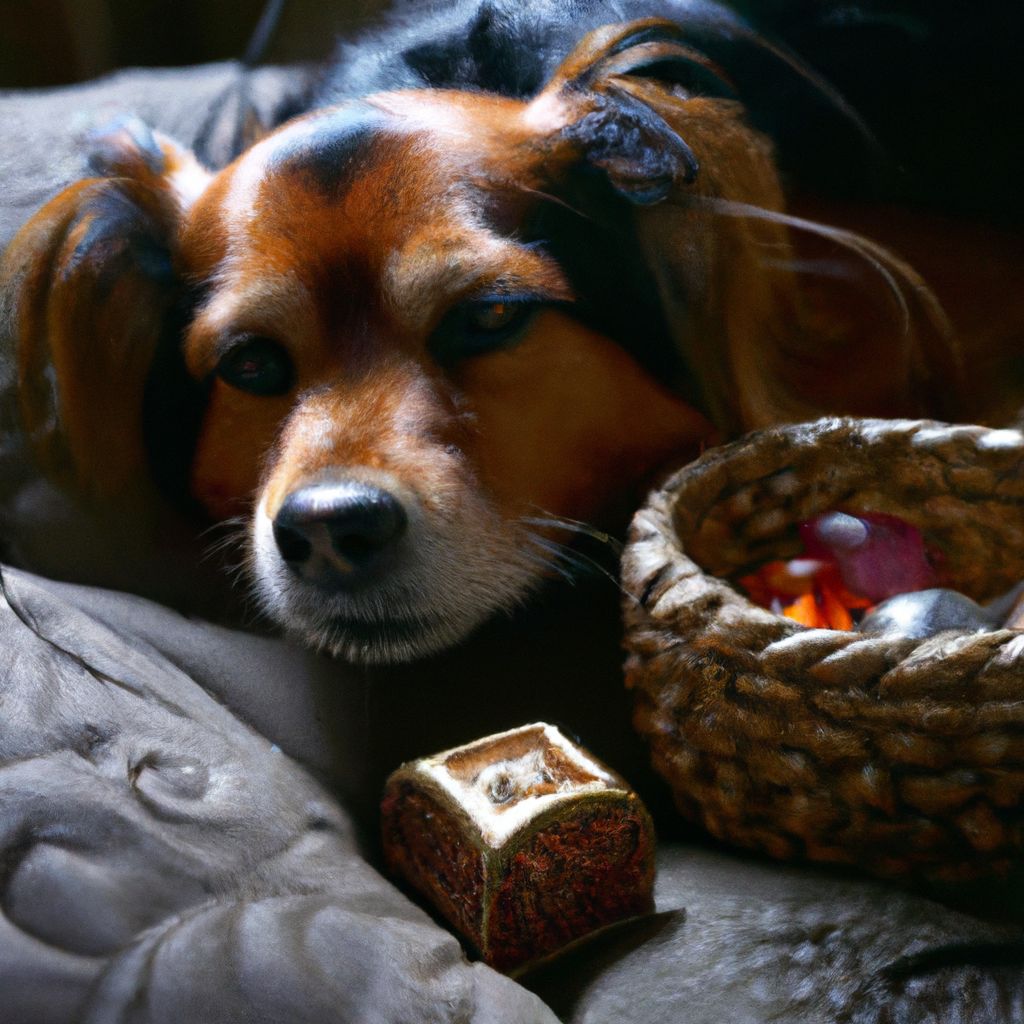Key Takeaway:
- The instinctual behavior of dogs can lead them to take things to their bed. This behavior is influenced by factors such as copying behavior, hunting instincts, hiding toys, resource guarding, and physical responses.
- The role of breed and genetics plays a significant role in why dogs exhibit this behavior. Understanding these factors can help owners better understand and address the behavior through training and intervention techniques.
- Providing mental and physical stimulation for dogs is essential in preventing or minimizing the behavior of taking things to their bed. Encouraging appropriate chewing, engaging in interactive play, and regular exercise can help fulfill their needs and reduce the behavior.
The Instinctual Behavior of Dogs
Dogs' behavior is often driven by instincts. Taking things to their bed is one such behavior. It may be due to their ancestral roots as hunters and scavengers, or it may be a way for them to protect their resources. Genetic factors, such as breed, can also contribute.
Training and intervention techniques can also shape their behavior. Providing mental and physical stimulation through appropriate training methods can prevent or minimize this habit. Interactive playtime and puzzle toys can give an outlet for their energy.
Understanding why dogs take things to their bed is important. It helps us provide a safe and content environment for our canine friends. Knowing that we understand their instincts can give them a sense of security.
Reasons Why Dogs Take Things to Their Bed
Dogs have a natural urge to take items to their bed. This can be due to different causes. For example, they may imitate the actions of people or other pups. Hunting dogs may store their “prey” in this way. Additionally, some canines hide toys for security and comfort. Resource guarding can also be a factor, as they feel the need to guard their possessions. Moreover, physical reactions such as carrying items in their mouths or using them for comfort can lead to this behavior.
It's worth noting that each pup's behavior depends on their breed and genetics. Training and interventions can help modify these behaviors, while mental and physical exercises are also essential. Puzzle toys, exercise, and other activities are good ways to address this behavior and provide outlets for their instincts. Knowing the reasons behind why dogs take things to their bed helps us better understand their needs and provide them with suitable activities.
The Role of Breed and Genetics


Different dog breeds can exhibit varying behaviors when it comes to taking things to their bed. In this section, we will explore the role of breed and genetics in shaping these behaviors. From behavioral factors to training techniques and intervention strategies, we'll delve into the fascinating world of how breed and genetics influence why dogs take things to their bed.
Behavioral Factors
Dogs' behaviors have a big influence on their instinctual actions – like taking things to their bed. The factors that drive this behavior are: copying others, hunting dog instincts, hiding toys, resource guarding, and physical responses. Knowing these behaviors helps when training and intervening to modify bad habits.
A table of the main behavioral factors is below:
| Behavioral Factors |
|---|
| Copying Behavior |
| Hunting Dogs |
| Hiding Toys |
| Resource Guarding |
| Physical Responses |
Each factor has its own effects. Copying behavior is when dogs imitate humans or other dogs while hunting dogs have a natural urge to collect and store objects. Hiding toys is an instinct to protect resources. Resource guarding is when dogs protect and claim items as their own. Finally, physical responses such as carrying things can give them comfort and security.
Understanding these factors is key to successful training and intervention. By finding which factor is driving the behavior, owners can tailor their approach. For example, hunting instincts can be redirected with mental and physical stimulation through interactive play.
To reduce or prevent this behavior, mental and physical stimulation is important. Exercise, playtime, puzzle toys, and training sessions can take their attention away from hoarding. Also, a consistent routine of exercise and mental activities can help use energy positively.
Dogs know they should copy behavior…unless it involves taxes or picking up poo!
Copying Behavior
Dogs often copy behaviors of those around them. This can be seen in various ways, such as mimicking the play style of another pup or picking up habits from their owners. They can even learn to bring toys or objects to their bed after seeing another dog do it. Dogs may even copy each other's toy preference and compete for resources. With appropriate training and reinforcement techniques, owners can shape their dog's behaviors. It's like dog owners are creating a treasure hunt in their pup's bed for when they're feeling lazy!
Hunting Dogs
Hunting dogs are bred and trained to aid hunters. Their instinctual behaviours drive them to capture and retrieve prey. They copy hunting techniques from experienced canines or humans. These dogs have excellent tracking sense due to their incredible sense of smell.
Their skills allow them to chase, corner and capture prey without harming it. They are also trained to retrieve shot game animals or wounded prey without damaging the carcass. Variations in hunting techniques and temperaments exist among different breeds.
Mental and physical stimulation is necessary for hunting dogs to maintain agility and focus. Exercise routines and puzzle toys should be provided. Training sessions are important to reinforce obedience commands for hunting partnerships. Establishing a strong bond based on trust and respect with the canine is essential.
Hunting dogs are remarkable animals with remarkable abilities. They are indispensable partners for hunters.
Hiding Toys
Dogs possess an instinct to tuck away their toys. Factors like genetics, training, and the need for physical and mental stimulation shape this behavior. Here's a 3-step guide to managing toy-hiding in dogs:
- Understand why: It could be copying, like what they see their owners or other dogs doing. It can also be a hunting instinct, since some breeds are selectively bred for it. Moreover, a dog may hide its toys as a form of resource guarding.
- Give them alternatives: To discourage the habit of hiding toys, provide them with other activities. Engage in interactive play and offer puzzle toys to stimulate their minds.
- Train and redirect: Train your dog to link positive behaviors with their toys. Encourage them to bring the toy back or place it in a designated area. Reward desired behavior with treats or praises.
It is essential to remember that each dog is unique and may exhibit different behaviors about hiding toys. By understanding the cause of this behavior and giving them mental and physical stimulation, you can prevent or reduce the habit of toy-hiding in your dog.
Resource Guarding
Resource guarding is when dogs protect and defend their stuff like food, toys, and other valuables. It may show as growling, barking, snapping, or even biting.
Dogs have particular traits that make them more prone to resource guarding. Certain breeds have strong hunting instincts or a natural inclination to hoard and hide stuff. It can also be their way of asserting dominance over humans and animals.
Training and intervention techniques can help with resource guarding. Counter-conditioning the dog's reaction to the item and teaching them an alternative behavior through positive reinforcement are key. Don't punish them though, it could make it worse.
To prevent or minimize resource guarding, physical and mental stimulation is important. Exercise, playtime, and puzzle toys can help relieve boredom and lessen resource guarding. Structuring mealtime and feeding dogs separately can also reduce resource guarding behavior.
Consult a professional dog trainer or behaviorist to get tailored guidance and support for your dog's specific behavior. With patience, consistency, and the right training methods, you can manage resource guarding in dogs effectively.
“Who needs a therapist when you have a dog that hides all your problems under the bed?”
Physical Responses
Dogs show various physical reactions when they take things to their bed. This is due to their instincts, breed genetics, and other behaviour factors. Training and intervention techniques can also influence these reactions.
- Copying: Dogs may take things to their bed after seeing other dogs or people do so. This copying behaviour is common among social animals.
- Hunting Breeds: Certain breeds have a strong hunting instinct. They may bring objects to their bed as if they were prey, due to their ancestral roots.
- Hiding: Dogs may take things to their bed to hide or protect them. This can be seen as an act of possessiveness or guarding resources.
- Resource Guarding: Some dogs may growl or snap if someone tries to take something from their bed. This is a protective response, displaying the desire to keep the object.
- Physical Responses: Dogs may carry objects in their mouths, wag their tails, or show other physical reactions when taking things to their bed. These are specific to the individual dog's personality.
In addition, certain breeds or individual traits can lead to more unique behaviours. To prevent any issues, dog owners should follow some tips. Exercise and enrichment activities can reduce the need to take objects to their bed due to boredom or excess energy. Also, teaching “drop it” or “leave it” commands during training sessions can prevent unnecessary carrying.
By understanding the physical responses of dogs when taking things to their bed, owners can gain insight into their behaviour. This helps in using appropriate training and intervention techniques. Providing mental and physical stimulation ensures a happier and more balanced life for furry companions.
Training and Intervention Techniques
Dogs take things to their bed due to certain instinctual behaviors. Genetics and breed can be factors. For example, different breeds may have different instincts or preferences for certain objects. Copying behavior, hunting dogs' natural inclination to bring back prey, and hiding toys can also be causes. Resource guarding and physical responses like comfort-seeking may also play a role.
Training and intervention techniques can help address this behavior. Positive reinforcement can be used to teach dogs alternative behaviors or redirection. Providing appropriate mental and physical stimulation can reduce the chance of them taking things to their bed. Interactive toys or increasing exercise routines can keep them occupied. Furthermore, desensitization training is another technique. This involves gradually exposing the dog to the item while using positive reinforcement. Associating positive experiences with leaving the item alone or finding an alternative location can help decrease the behavior.
For successful implementation, consistency and repetition are key. Additionally, professional trainers or animal behaviorists can provide valuable insights. In conclusion, understanding the causes and using the right training and intervention techniques can help dogs develop healthier habits.
The Importance of Mental and Physical Stimulation
Engaging our furry companions in both mental and physical activities plays a crucial role in their well-being. In this section, we'll explore the significance of mental and physical stimulation for dogs. Discover practical tips and strategies to prevent or minimize behaviors like taking things to their bed. Ensuring a balance between a dog's mental and physical needs is essential for a happy and healthy canine companion.
Tips for Preventing or Minimizing the Behavior
To stop or reduce the habit of dogs carrying things to their bed, there are several steps to take. One important part of training dogs and managing their behavior is understanding why they do it and using the right methods to handle it.
- Give Sufficient Mental & Physical Stimulation: Dogs might do this out of boredom or lack of stimulation. Making sure your dog gets enough mental and physical activity can help stop or reduce this behavior.
- Instruct a “Drop It” Command: Training your dog to drop items on command can help prevent them from taking things to their bed. This command should be praised and practiced often.
- Set Clear Boundaries: Setting clear rules for your dog about what items they can have and where they can bring them stops them from always carrying objects to their bed. Keeping these rules constantly is important.
- Provide Suitable Chew Toys: Dogs may take items to their bed to find comfort or ease teething pain. Giving appropriate chew toys that meet their need to chew can direct this behavior onto okay items.
It's also worth noting that each dog could have unique factors causing this behavior, like breed tendencies, genetics, or learned behaviors. Knowing these individual factors can give further clues into effective prevention strategies.
Along with the tips above, it's essential to consider the special needs and character of your dog when managing this behavior. Factors such as age, health condition, and environment play a big role in finding the right interventions.
To stop or reduce the habit of dogs carrying things to their bed:
- Always make sure your dog has access to mental and physical exercise.
- Train your dog with positive reinforcement methods, including teaching a “drop it” command.
- Set clear rules for your dog regarding possessive behaviors and keep them consistent.
- Give appropriate chew toys that meet your dog's need to chew and reduce teething discomfort.
By using these tips, you can successfully stop or reduce the behavior of dogs taking things to their bed and make sure your canine companion is healthy and content.
Conclusion and Key Takeaways
To sum up, dogs carrying things to their bed is a natural instinct. It's due to resource-guarding habits plus the wish for comfort and safety. Knowing and respecting this action can help pet owners give their dogs a secure and relaxed atmosphere.
It's worth noting that different pooches may have different reactions to this behavior. Some may be more prone to resource-guarding, thus more likely to bring items to their bed. Others may not do this as often. Additionally, the objects they carry to their bed can differ: toys, bones, shoes, socks, etc.
Some Facts About Why Do Dogs Take Things To Their Bed:
- ✅ Dogs may take things to their bed as a way to feel safe and secure. (Source: Team Research)
- ✅ It is also a way for dogs to mark their territory and establish ownership. (Source: Team Research)
- ✅ Dogs may bring toys or objects to their bed to engage in play and relieve boredom. (Source: Team Research)
- ✅ Some dogs may bring items to their bed as a form of comfort or to seek attention from their owners. (Source: Team Research)
- ✅ Taking things to their bed can be a natural behavior for dogs, but it can also occur due to anxiety or possessiveness. (Source: Team Research)
FAQs about Why Do Dogs Take Things To Their Bed
Why do dogs have a natural instinct to dig in their beds?
Dogs have a natural instinct to dig in their beds due to their ancestral history. Some breeds, like terriers and hunting dogs, have been bred to be instinctive diggers as it was once necessary for them to dig and burrow to find prey or create shelter.
Is it normal for dogs to dig in their beds when preparing for puppies?
Yes, it is normal for dogs to dig in their beds when preparing for puppies. Female dogs often dig and rearrange their bedding to create a comfortable and secluded space for their impending litter.
How can I stop my dog from digging in their bed?
To stop dogs from digging in their beds, it's important to redirect their digging behavior to a designated area, such as a sand or dirt box. Providing them with other activities that stimulate their senses and mental abilities can also help distract them from digging in their beds.
Why do dogs hide food or toys in their beds?
Dogs may hide food or toys in their beds as a natural instinct derived from their ancestors who would bury food to save it for later. It can also be a way for them to keep their possessions secure or as a way to mimic the behavior of other dogs.
Can digging in their bed become a compulsive behavior?
Yes, digging in a dog's bed can become a compulsive behavior. If a dog excessively and destructively digs in their bed or other areas, it could indicate underlying anxiety or compulsive behavior that may require intervention and behavior modification techniques.
Which dog breeds are considered instinctive diggers?
Some dog breeds that are considered instinctive diggers include terriers, dachshunds, beagles, and other hunting or working dog breeds. These breeds have been historically bred for hunting and retrieving tasks that involve digging and burrowing.




